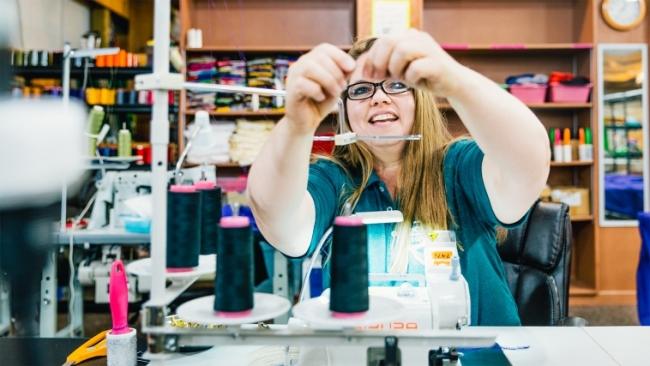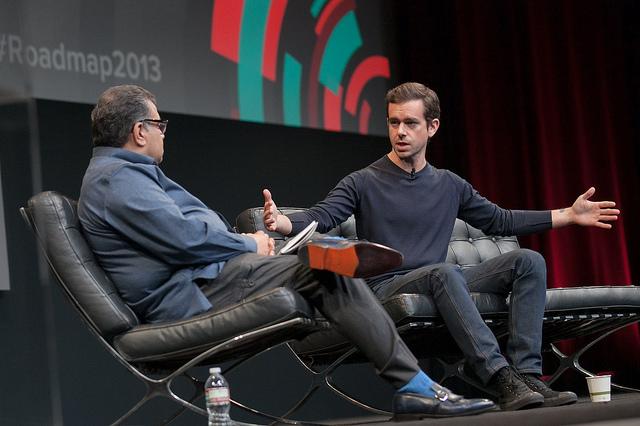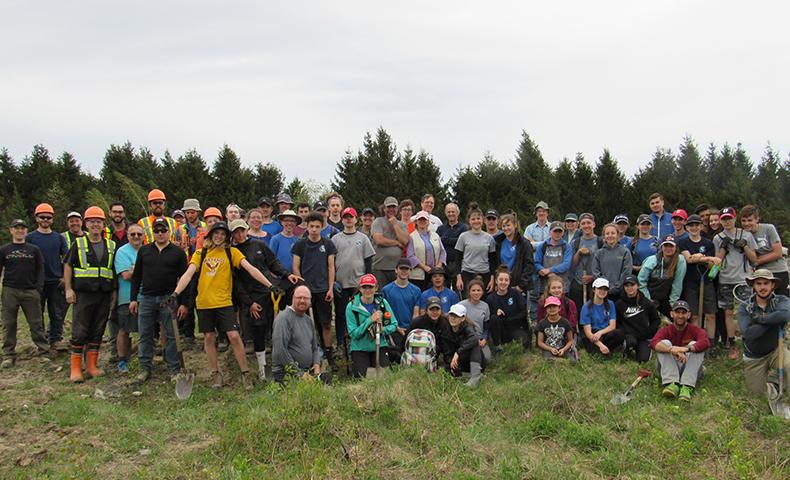What Is Old Is New - Norsepower Brings Back Wind Power to Commercial Shipping


For centuries, global commerce was powered by the wind. Sailing ships traversed the globe unchallenged up until the mid to late 1800s, when the rise of the steam engine saw the beginning of fossil-fuel powered dominance. By the early 1900s masts had almost entirely disappeared from the world’s shipping fleets and while steam gave way to the internal combustion engine - commercial sailing ships, of course, had become history.
But after well over a century, wind powered ships could be making a bit of a comeback - at least within the global logistics sector.
On August 30, Norsepower Oy Ltd., together with project partners Maersk Tankers, Energy Technologies Institute (ETI) and Shell Shipping & Maritime announced that the Maersk Pelican - an oil tanker - has been retrofitted with a pair of Norsepower’s 30 foot high rotor sails providing auxiliary wind propulsion for the vessel.
Wind won’t be the dominant means of power for the Pelican but on typical global shipping routes, the rotor sails are expected to harness sufficient wind power to reduce fuel consumption and emissions by up to 10 percent, according to the joint press release.
A 10 percent reduction may not sound huge - and some may note the irony of using wind to move oil in the first place - but these massive vessels are extremely thirsty. Cargo vessels and tankers, of course, come in a variety of sizes but as this article from More Than Shipping describes, it is not uncommon for ships to consume a couple of hundred metric tons, or more, of fuel per day. Such energy savings on such large quantities represents significant dollars saved, which is important since fuel expenditure represents around 50 to 60 percent of total vessel operating costs.
The rotor sails developed by the the five-year-old Finnish company look nothing like the familiar wind-filled sails gracing ships of old, but they are not a new invention. Norsepower has innovated and brought into the present day an iteration of the Flettner sail, named after an early pioneer of the technology, Anton Flettner, who designed the first rotor sail powered ship, the Buckau, in the mid 1920s.
The science behind the Flettner sail is an aerodynamic phenomenon known as the magnus effect. When wind encounters a rotating cylinder, a pressure differential is created on either “side” of the cylinder, which creates a lifting force perpendicular to the direction of the wind. In this application, the force harnessed by the rotor sail provides the necessary thrust to move the ship along. The magnus effect is what can be observed when a curve ball is thrown, or when a tennis player hits a topspin shot causing the ball to dip downwards.
It’s a simple principle, and unlike traditional sailing ships of eons past, no ropes or complicated rigging get in the way of the ship’s operation. Norsepower’s sails use low voltage electrical power to spin the rotors, and when wind conditions are favorable, the system is activated by the press of a button allowing the conventional engines to be simultaneously throttled back. Speed is maintained by auxiliary wind, while fuel is saved.
Norsepower says the rotor sails fitted to the Pelican are the largest in the world, and the ship will shortly make its maiden voyage using the technology. Over a test period an analysis of performance will be undertaken by independent experts from Lloyd’s Register for future reporting.
According to the press release, this is the third application of Norsepower’s rotor sails onboard different vessel types. As well as product tankers, (the official classification of the Pelican), the technology is well suited for bulk cargo ships and roll on roll off (ro-ro) vessels.
Norsepower says the technology promises to be an effective way to reduce carbon emissions. One of the three vessels so far outfitted with Norsepower’s rotor sails, a ro-ro vessel, saved 1,200 metric tons of carbon emissions on an annualized basis. And since the industry is also bracing for possible new regulations on sulfur emissions too, technology like this could gain increasing traction.
Furthermore, on top of potential environmental regulations, the shipping industry is facing rising fuel costs at the moment too; in the last 12 months, bunker fuel prices have increased from around $350 per metric ton to around $500 per metric ton. In a DHL market update in July, the company warned of increasing shipping rates due to higher fuel costs.
In short, there’s pressure on the industry to enhance efficiency. Innovations such as Norsepower’s rotor sails could be an important solution to meeting those pressures in a volatile future. Perhaps we will once again see more sails on the high seas.
Image credit: Ace Media/Norsepower
Ben & Jerry's Gets a New CEO -- and He's Not Just About Ice Cream


Ben & Jerry’s new CEO has big plans for the country’s third-leading ice cream company. And it’s not all going to be about new flavors.
Matthew McCarthy is a veteran marketing specialist who has more than two decades under his belt at Unilever. According to a recent press release, he’s quintessential proof that not everything about marketing is about sales. The company is very much about pushing corporate social responsibility (CSR) forward and developing ideal models that give back to the community while promoting the company’s product.
In a recent CNBC interview McCarthy was drilled about his ideals and his perspectives toward the company ideals, social values and how Ben & Jerry’s could further its role as a leader in communities. A panel of four journalists bombarded him with questions.
“Businesses are in business to serve people, whether you make products [or provide] services. And you are also embedded in communities,” McCarthy said matter-of-factly. “So I think acknowledging that you are part of a community and being part of the social change you want to see be a part of the world you serve is actually a part of business – I actually think that’s in the DNA of Ben & Jerry’s.”
One reporter asked if he was worried about losing conservative consumers. “I mean, that’s a pretty liberal agenda you’ve got there,” she suggested.
McCarthy was unflinching but acknowledged that not everyone may agree with his position. He then went on to smoothly suggest that the real topic should be how to bridge that divide through conversation. “Let’s have a dialogue, let’s have a discussion about it,” he countered.
“Might we alienate some people? Perhaps. But I think that’s what it takes to step in and be proactive as a business ...”
What’s interesting was how little the company’s ice cream products figured in the discussion. This was about a company’s successful social action platform, which just happened to be complemented by a very successful product. It was about the importance of CSR, to be a part of a community and to advocate for change as part of its defining success.
And the discussion about how to advocate for change was happening on mainstream TV.
Perhaps one of the reasons McCarthy seems so comfortable talking about social change is that many of Unilever’s CSR initiatives were either founded or implemented with his help. He is reportedly responsible for suggesting Hellmann’s Mayonnaise change its supply chain to include certified cage-free eggs. He also advocated for better living conditions for chickens in other supply chains and helped to create an organic snack brand that could support farms in underserved communities. And outside of his role in product marketing, he also helped to launch a men’s working group for gender equality at Unilever.
McCarthy’s first big goal, he says, is to “double the social impact” of Ben & Jerry’s. That’s a tall order for a company that has its roots in 35 countries and is known just as widely for its social action as for its ice cream.
But McCarthy maintains that activism is needed, particularly now, and particularly in the U.S., where “never before have we had a lot of issues bubbling to the surface.”
“I think business is at a big inflection point,” said McCarthy.
It will be interesting to see where McCarthy is able to take the effort to double social outreach and resolve intractable differences. Social values may be taking an even greater lead for the Ben & Jerry’s brand, but nothing is likely to smooth over feelings and forge consensus of viewpoints than a good bowl of old-fashioned ice cream.
Image credit: Ben Ramirez (Flickr)Food and Agriculture Companies: A Challenge From a Millennial Mom


As a working mother, I often have to multi-task. Recently, as I watched my toddler push his food around his plate, I caught up on last week’s news that Fortune had released its annual “Change the World” list of top companies using the profit motive to help the planet and tackle social problems.
About 10 percent of this list consists of corporate leaders who are thinking critically about the challenge to feed our world in a sustainable way without destroying our planet, including companies like Kroger (#6), Walmart (#16), Tyson Foods (#44), McDonald’s (#50) and PepsiCo(#57). These companies know that a thriving community requires a fed community.
While I’m thankful to Fortune for sharing best practices from these incredible, game-changing companies, I’m also painfully aware that the corporate sector at large has a lot more work to do: a recent survey by Bain & Company found that only four percent of companies feel that they’ve succeeded in achieving their sustainability goals, while 47 percent feel that they’ve failed altogether.
Speaking as both a mother and a sustainable supply chain specialist, that’s simply not good enough. We are already facing the massive challenge of producing even more food with fewer inputs. We are already facing increasingly variable weather. And in just a few decades, our planet will be home to 2 billion more people to feed.
What’s my point? Next year, food and agriculture companies, I want to see more of you on Fortune’s list. So to help you on this quest, I’m officially issuing you a two-part challenge:
I. Engage every part of your supply chain
This means going after your Scope 3 emissions, which encompass every component – from product design to end use – of your company’s supply chain.
For agricultural supply chains, there are three main stakeholders: farmers, companies and consumers. It’s important to ensure farmers are rewarded for their stewardship, companies feel knowledgeable about reducing their supply chain risk and consumers have access to transparent information about their environmental footprint from the foods they eat. Trust me: I am not the only mother who cares about the path food takes from the farm to my baby’s plate.
Translating across these groups requires patience and creativity. It also requires compromises and trade-offs. Grocers and food retailers are stepping up to show they can make a difference, but from their unique position in the middle of the supply chain, they have the opportunity (and an obligation) to engage both with their agricultural suppliers, as well as with everyday consumers, like you and me. Managing Scope 3 emissions both upstream and downstream isn’t easy, but it pays off.
I won’t lie: getting alignment across this diverse array of nodes can be slow, complicated and even tedious (imagine how different the needs and pressure points are between, say, growers and consumer packaged good companies or retailers, who are on opposite ends of the chain).
The key to even getting started on alignment? Collaboration. There are many, on-going ways to “partner up”, such as:
- With an environmental NGO, such as EDF, WWF, TNC, TSC, or CI. We all have different specialties and skills, but we all exist to help you succeed. Call us!
- With your suppliers. In the past year, nearly 20 major suppliers, representing about 30 percent of food and beverage sales in North America, have looked across their supply chains and developed collaborative plans to reduce fertilizer runoff and improve soil health.
- As part of an initiative: EDF+Business is collaborating with companies like Smithfield, Campbell Soup Company, and Land O’Lakes in response to Walmart’s fertilizer optimization goal. The Land O’Lakes SUSTAIN platform aims to enroll 20 million acres in sustainable farming practices by 2025.
- Across your industry: EDF is a part of the Midwest Row Crop Collaborative, a group of companies and NGOs that shares best practices in row crop agriculture in order to scale supply chain solutions.
Food and agriculture companies specifically have an opportunity to invest in farmers, rural communities and water quality while simultaneously reducing emissions from the sector that contributes to 9 percent of the US’ total footprint. Alignment up and down the chain like this offers up a wealth of opportunity.
So please accept my challenge, food and ag companies. You truly will be “changing the world” – a feat that will not only get you noticed by Fortune, but will win you accolades from your customers and shareholders as well.
For more posts like this, follow Sara Kroopf on Twitter.
Previously posted on the EDF+Business blog and 3BL Media news.
Technology Can Help Counter the Forces of Economic Concentration


While the overall U.S. economy is on one of its longest expansion periods in history, widespread concerns continue that too many communities are being left behind. Growth and opportunity are not spreading in a balanced or inclusive way. This has been attributed to factors such as rising levels of income and wealth inequality, increased costs of a middle-class lifestyle, and a lack of economic mobility.
If you look at entrepreneurial activity in the United States on a geographic basis, the division between haves and have-nots is striking. The Distressed Communities Index, a report by the non-partisan Economic Innovation Group (EIG), ranked every county in America based on factors such as employment, income, education, homeownership, and new business formation to measure and rank the economic vitality of U.S. counties relative to their peers. Counties were divided in well-being quintiles – Prosperous, Comfortable, Mid-Tier, At Risk, and Distressed. These quintiles we reach made of up of approximately 600 counties facing progressively greater social and economic challenges. New business formation in the counties populating the lower quintiles were depressed to non-existent.
eBay Small Business Formation is More Balanced and Inclusive than the Overall U.S. Economy
At eBay, we believe that providing open, global, technology-enabled commerce platforms to independent small businesses and entrepreneurs, connecting them to millions of buyers around the world, empowers a people-driven kind of inclusive global commerce. eBay delivers the latest technology-driven retail tools and innovations to local merchants and entrepreneurs, opening global opportunities and providing a boost to Main Street small businesses whether they are thriving in a growth hub or faced with a deeply challenged local economy. And we wanted to see if the data on small business entrepreneurship on eBay confirmed that our commerce platform was truly pushing back against these negative national trends toward economic concentration.
The eBay Public Policy Lab analyzed the growth in the number of eBay Commercial Sellers -- small business sellers engaging in at least $10,000 in sales on eBay per year -- on a county-by-county basis from 2011 to 2015, looking at the results along the well-being quintiles established by the EIG Distressed Communities Index. The same county-by-county analysis of net enterprise formation was also done for the overall economy using U.S. Census Bureau data. The eBay Public Policy Lab report confirmed that net enterprise formation on eBay was meaningfully more balanced and inclusive than was occurring in the overall U.S. economy.
“Balanced” Economic Growth
A geographically balanced economy is one in which people enjoy a relatively equal opportunity to benefit from economic growth, regardless of where they live. On the other hand, an economy where economic opportunities and growth is highly concentrated in a small subset of communities is out of balance. Based on rates of new enterprise formation in counties spanning the EIG Distressed Communities Index, eBay small business growth was 5.7 times more balanced than in the overall economy. Yes, the number of eBay small businesses in the top two well-being quintiles increased 21.2% and 24.7%, but the growth rates in the bottom two quintiles were also robust at 16.8% and 16.7%. Compare that to the overall economy where growth in the number of business enterprises in the top two quintiles was 6% and 4.8%, but in the bottom two was an almost non-existent .5% and negative 2.8%!
Inclusive Opportunities for Economic Growth
Taking a step beyond balance, an inclusive economy provides opportunities to those who are less advantaged. We therefore focused attention on growth in the number of enterprises across the bottom three EIG county quintiles, those being Mid-Tier, At Risk, and Distressed counties. Those counties are home to nearly 100 million Americans! Again, the data revealed that eBay Commercial Seller growth was substantially greater than traditional establishment growth to the tune of 19.3% vs. less than 1%. In addition, we looked at the contribution to overall enterprise growth coming from those counties. On eBay, they contributed 20.4% of growth, while in the overall U.S. economy, less than 4% of all the enterprise formation came from those more-challenged counties. In short, eBay small business formation was 5.6 times more inclusive than the overall economy.
Improving Lives and Communities
We must not lose sight of the fact that there are real people behind these numbers. The ability to harness technology to allow a local entrepreneur in an At-Risk or Distressed county to improve their economic prospects, and with them their local community, pays real dividends in people’s lives. For example, Spencer Apland is an eBay seller from Josephine County, OR, which shed nearly 4% of its business establishments from 2011-2015 and is classified as an At-Risk county in the EIG index.
About ten years ago, Spencer was in business school but not quite sure of the career path he wanted to pursue. A do-it-yourself mechanic, he bought a wrecked car for parts to fix his own vehicle and had a revelation: maybe he could sell the “leftovers” on eBay. One sale led to another, and pretty soon he was moving enough units to quit school and start his own business. 541-Motorsports was born and began operating in a 1,200 square foot warehouse, which it outgrew in one year. By 2015, 541-Motorsports continued its rapid growth and pace, and Spencer began adding employees and square footage to try and keep up with the increasing business demand. He eventually brought his wife Megan into the business full-time along with two other employees and moved to a 2,500 square foot warehouse, which they quickly outgrew again. Today, 541-Motorsports has eight full-time employees, 15% of their sales come from exports largely facilitated by eBay’s Global Shipping Program, maintains a 20,000 square foot local warehouse and is a technology-powered independent small business growing in a challenged local economy.
Technology as a Counterweight to Economic Concentration and Divergence
The increasing disparity in opportunities available to people living in disadvantaged communities vs. those for Americans living in booming hotspots is a valid and growing concern. Instead of blaming technology and global commerce, they help entrepreneurs access customers across the U.S. and around the world and help regions that are falling further behind. The results are more balanced and inclusive economic opportunities and stronger communities across the country.
Image credit: eBay
Previously posted on eBay Stories and 3BL Media news.
Forged by Immigrants, NYC's Historic Flower District Faces Demise


New York City’s Chelsea district has long been known for its history as a melting pot of immigrants, small legendary businesses and fanciful dreams to make a better life. But these days one Chelsea neighborhood in particular is facing mounting challenges to survive.
Rising rents are making it harder for businesses in neighborhoods like Chelsea’s vibrant flower district to meet their costs.
But that’s not the only reason why this collection of small storefronts, many of which have been passed down from generation to generation, is shrinking.
U.S. Immigration and Customs Enforcement’s (ICE) endemic raids across the city is changing the landscape of districts that once served as starting points for immigrant families.
According to the Immigrant Defense Project, which developed the interactive program, ICEWATCH, to track visually the number of immigrant arrests across the country, there were an estimated 665 arrests across the state of New York between 2013 and July 2018. More than half, says the nonprofit, have occurred within city limits and about two-thirds of that 665 have taken place since President Trump was elected.
While ICEWATCH carefully notes this is only an approximation, publications like The Intercept and City Lab point out the real concern about ICE’s impact on New York’s immigrant population: not all of those arrested are either in the U.S. illegally, nor were they the original immigrants targeted in the sweep.
For areas like the flower district, which depends largely on tourism, commercial and upscale sales, the impact is worrying. One business owner interviewed by Bloomberg writer Riley Griffin said potential applicants are being scared away by ICE’s targeting of the flower district. “[The workers] pay taxes. They are wonderful people. These are stand-up success stories,” she said referring to the immigrants that have worked for her business, many of whom went on to become U.S. citizens. “[But now] I can’t get a single person in.”
Of course, it isn’t just ICE that is driving these historic shops out of business. The 2008 recession provided the first big blow to an industry that has always been about supply and demand, and relies heavily on a consistent workforce to tie them together.
And Chelsea's flower district also relies on stable economic factors. Increasing demand for real estate in the Chelsea area, both for the burgeoning tech industry’s commercial development and for housing, is putting the squeeze on long-term renters that have largely survived as small mom-and-pop businesses. Meanwhile rents across much of Manhattan have doubled at twice the rate of wages. The result is a perfect storm forcing many of the city’s niche flower businesses to move and leave Chelsea behind.
Still, that won’t solve the industry’s employment woes. With often sketchy information about just how many deported immigrants were actually of non-legal status when they were arrested, many potential workers are understandably reticent to apply – even if the work is in a neighborhood that was largely built by immigrants.
Image credit: Kristine Paulus/Flickr
The Unanticipated Benefits of California’s Water Policies


Just as California's climate policies have driven innovation in energy efficiency, renewable energy and battery storage – creating 500,000 new jobs – many of the state’s recently enacted bills are beginning to drive innovation in water technology. State policymakers should take note.
These technologies, in turn, are poised to bring about new jobs and economic growth in California, while supporting the policy goals of creating more robust water utilities and better drought resilience for the state.
A good case in point are the new water efficiency measures, Senate Bill 606 and Assembly Bill 1668, signed into law in May, which evolved from the emergency water conservation regulations put in place during the drought. Coupled with the water loss management act, Senate Bill 555, the Sustainable Groundwater Management Act and the Open and Transparent Water Data Act, this series of new policies is beginning to spur a market for tools to help water utilities and users better manage their infrastructure and water use.
“Water efficiency [policy] is fueling an innovation economy around water,” said Nashelley Kaplan-Dailey, senior manager at Imagine H2O, a nonprofit organization that provides business accelerator programs and mentoring to promising water technology startups.
Ceres turned to Imagine H2O for insight on technologies under development in the water industry that respond to some of the new policy mandates. At Imagine H2O, Kaplan-Dailey focuses on the intersection between policy and innovation through the organization’s partnership with the Milken Institute California Center.
“Having regulatory clarity from the government opens up opportunities for innovation,” she added. “Policy has played a central role in the growth in the renewable energy sector – we think the same can be done in water.”
The water efficiency bills, S.B. 606 and A.B. 1668, direct the State Water Resources Control Board (SWRCB) to develop standards for water use for various activities and, once those are in place, will require water utilities to create budgets based on those standards plus factors for their particular geographic needs.
One of the best approaches for many water utilities operating under restricted budgets is finding and repairing leaks in infrastructure that cause them to lose water – and money. Because the water seeping out of cracks and loose valves is already treated and pumped through the distribution system, but never gets to end users, it costs utilities money without bringing in any revenue.
Leaks are problematic for water utilities everywhere. The federal Environmental Protection Agency estimates that the average United States water utility loses 16 percent of its treated water to leakage; California’s average is in that range. Given the state’s frequent drought conditions, which will only grow worse with climate change, water loss is particularly worth solving here. The problem is that finding and repairing infrastructure leaks in underground pipes has been an expensive proposition.
But now technologies involving robotics, satellites, artificial intelligence and data mapping have come on to the market and they are taking the expensive guesswork out of finding leaks. For instance, WatchTower Robotics developed a small, sensor-laden robot housed in a rubber bubble that can be sent floating through pipes to detect leaks. Its sensors collect images and other data about the pipes and send that data to an analytics platform, which indicates where a system has ruptures. Another startup, Utilis, has adapted satellite imagery technology used to look for water on Mars into a tool that detects leaks and reads the condition of underground pipes from above.
“We see a ton of new leak-detecting technologies popping up,” said Kate Gasner, a director of Water Systems Optimization, which created the platform used by utilities in California to conduct the water audits required by S.B. 555. She added that water utilities are still assessing their infrastructure systems, but likely soon will be evaluating the tools that are on the market to help them control leaks.
California’s Sustainable Groundwater Management Act (SGMA), passed in 2014, requires that regional users of water pumped from stressed groundwater basins develop groundwater management plans. Those need to include plans for replenishing aquifers, how to be efficient in water use and how to fairly apportion available water. Some groups devising groundwater management plans are including reuse and recycling, such as the Oxnard Basin plan in Ventura County.
Responding to the need to develop smart and sustainable groundwater management plans, Hydromodel Host SL created a software platform that generates models of groundwater basins and incorporates data to allow users to run complex scenarios for decision-making.
“Data that improves decision-making” can be a compelling investment for any entity, water users included, said Tom Ferguson, vice-president of Imagine H2O.When customers look for data analytics solutions, he said, they are really after improved decision-making.
The Open and Transparent Water Data Act of September 2016 required the state to develop an open-platform online data repository that is available to all water suppliers and users. Since water utilities feed data to that platform and can use the database to make decisions, it encourages them to have adequate data systems themselves.
A slew of data analytics companies has started up to help water districts make use of data. They include WaterSmart and DropCountr, which go beyond water flow and engineering data to include customer support data. These programs are already fairly widely used among larger water utilities. Some other startups have created data analytics tools infused with artificial intelligence to help water companies optimize decision-making. Emagin, Fracta and Plutoshift use A.I. to take the guesswork out of timing, treatment and engineering decisions.
The California legislature is considering two measures to improve access to clean drinking water, S.B. 844 and S.B. 845, and another measure, S.B. 966, that encourages water recycling in gray-water applications – both critical policy efforts for the state. If adopted, these policies would likely further spur water innovation.
In many markets, including energy, cost is a driver – with the search for lower costs often being what propels the adoption of technology. In the U.S. water is priced cheaply, relative to its value: It is essential for families and communities.
What the cheap price of water means in the market, however, is that there’s not often a price problem to try to solve through innovation. Yet like water utilities across the nation, many in California have aged infrastructure and scant capital budgets to maintain or improve infrastructure.
That is exactly why policy is so important for water innovation, both to make sure this shared resource is universally accessible to all and to drive better management and careful use of this shared resource.
Ceres does not endorse technologies; the companies mentioned in this article and those technologies listed are by no means a comprehensive list of potentially useful technologies. But it is important to note that the market-based policy approaches that were so helpful in developing clean technology and renewable energy in California are beginning also to work in the water world. That is something policymakers should keep in mind as new water management policies start to flow to the forefront of debates.
This blog was originally posted on Water Deeply and on 3BL Media news.
Image credit: Leon Kaye
Hate Speech and Innuendo: Should Twitter and Other Companies Do More?


For years, social media companies like Facebook, Twitter, Google and YouTube have been trying to answer a question: what responsibility do they really have to meet the public’s own definition of free speech?
Here in the U.S., we generally think of “freedom of speech” to mean the right to express opinions. But what happens when those opinions – including the data used to presumably support those statements – are offensive or have the potential to harm others?
It’s worth noting that not all countries agree that the right to express opinion is the same as the right to post material without limitations. Germany’s restrictions on Holocaust denial and the EU’s recent battles over hate speech are good examples of bars that have been deliberately set by countries, ostensibly in the protection of others. They underscore the concept that freedom of speech in any venue can come with consequences.
Still, it’s a question that while there are lots of legal precedents in workplaces across the U.S., has largely been left to the purview of social media companies to answer – and answer on their own.
In the last few weeks a number of social media outlets have stepped up to take action on that issue. Or, that is, they have in relation to one highly controversial public figure and his website. After viewers began complaining about the material that was being circulated by Infowars’ website owner Alex Jones, a number of social media companies took action, banning Jones and his program from accessing their sites.
Only one company eventually rescinded the ban. Twitter, after a “temporary suspension” of one week, lifted the limitation and reversed its assertion that Jones had violated the company’s standards of conduct.
Twitter CEO Jack Dorsey later defended the reversal in several media interviews. His defense was that the company could not find evidence that Infowars or its spokesperson had broken any specific rule when it published statements asserting, among other things, that the massacre of children at Sandy Hook Elementary School was a hoax.
For Dorsey, the fact that Jones’ statements are now the subject of a lawsuit by the families of the children and an FBI agent that were killed in the shooting was not material enough to consider that its standards may not match the public’s acceptance of what is free speech.
The legal complaint against Jones suggests that fact wasn’t an issue for Jones; he knew his statements were erroneous. Profit and viewership were the key motivators in this case.
“The Jones defendants concoct elaborate and false paranoia-tinged conspiracy theories because it moves product and they make money," the suit alleges. "Not because they truly believe what they are saying, but rather because it increases profits."
But is that enough of a reason to call Jones’ words “hate speech?” And is it enough to ban Jones for making assertions that could incentivize hate toward others?
Or does Twitter, and other social media organizations, have a responsibility to monitor issues of truth and fact on the pretext that false assertions can eventually cause hate, discrimination and foment violence?
For Dorsey, who has tried hard to defend the need for a “healthy conversational environment” from all sides, the argument that asserting false narratives that aren’t backed up by authoritative data don’t violate Twitter’s standards may be a slippery slope.
Like Facebook, Twitter is fueled by user trust. And it’s fueled by the assumption that wild assertions made by one user won’t incentivize hate toward another.
Most companies these days monitor employee (and customer) conduct as a barometer of broader, potential problems. And what we often forget is that those standards grew out of a convergence of public pressure and legal rulings in the 1950s, 60s and 70s that made it necessary to set standards – including to increase diversity or against statements viewed as harassment toward a group or a person. But today it’s pretty much assumed that a person who can definitively show proof that wild rumors or widely circulated falsehoods were, or caused harassment may well have the chance of a case in court.
Of course, this tug of war between social media sites and Infowars supporters isn’t yet over. Facebook, Google and Apple have been accused by InfoWars viewers of trying to silent conservative voices. And while there’s data that shows that Facebook’s community standards have not been exclusively applied to conservative users, the question of whether conservatives are losing access to the world’s biggest podium is now fodder for the Trump administration.
And this may be part of the reason why Twitter is reluctant to ban Jones: because in creating standards that require accuracy in statement and recognize the potential for harm from falsehoods about others, Dorsey subjects his company to the headache of monitoring the accuracy of the Trump administration's official tweets, something that a plethora of companies and organizations, except for Twitter, are already publishing.
It will be interesting to see how Dorsey's decision not to impose further sanctions against Alex Jones and Infowars plays out. If Facebook's experiences with controversial decisions and user dissatisfaction is anything to go by, Twitter may not be done writing its rules on user conduct.
Image credit: JD Lasica/Flickr
Billy Cable, the 2018 Aflac Corporate Responsibility Hero


Previously posted on 3BL Media news and Reuters Insider.
Image credit: Texas Military Department/Flickr
Europe To Ban Halogen Bulbs in September - Will The U.S. Do The Same?


On September 1, the era of the halogen light bulb will begin to flicker and die across the European Union as after this date, retailers will no longer be permitted to restock them for sale. While existing inventory may still be sold, over time, halogens will almost completely fade from existence across the continent.
The halogen bulb has been around for about 60 years and is an iteration of the traditional incandescent light bulb. The innovation uses halogen gas around the bulb’s filament which improves light output, efficiency and longevity. But now, as with the traditional incandescent bulb - which the EU banned in 2009 - those efficiency benefits have been dramatically superseded by LED technology. So, aside from just a few remaining specialty uses of the halogen bulb, such as oven lighting, the EU has decided it’s time to move on.
Not everyone is happy of course. Halogen bulbs are cheap to buy, and opposition voices to the ban say that the move to LED’s will hurt the consumer - but that is to consider only the purchase price of the bulb. As LED’s are five times more energy efficient than halogens and last 15 to 20 years compared with the average two-year life cycle of a halogen bulb, a recent Forbes article says the European Commission estimates consumers will actually enjoy a savings of 115 Euros over the lifetime of an LED bulb, or close to $150.
As well as consumers saving money in the long run, big energy savings will be enjoyed on aggregate across the EU too. According to a report by CNN, the halogen ban will save the EU up to 93 teraWatts each year by 2020, equivalent to the amount of energy Portugal consumes annually, while the Guardian reporting on the new law says Europe will mitigate 15 million tons of carbon emissions a year.
Similar developments are afoot in the United States, too, which will hopefully bring significant benefits. As reported in the Sacramento Bee, back in the George W. Bush era, a 2007 bipartisan congressional bill was signed into law to phase in new standards for light bulbs by 2020. Perhaps there’s time for lawsuits to scupper such plans, but halogens could disappear in the USA too as a result of the 2007 law, though on slightly different terms.
As is often the case, California has led the way, bringing regulation to bear two years ahead of federal requirements. Since the beginning of this year, the state has prohibited retailers from selling bulbs that fail to meet new energy standards, if manufactured after January 1st, 2018.
While not dictating an outright ban on halogen or incandescent lamps specifically, the California approach sets energy performance standards instead. As this NRDC fact sheet details, new bulbs sold in the state must meet a minimum efficiency level of 45 lumens per watt (LPW), which means they must be roughly three times more energy efficient than old-school incandescent bulbs. Of the technology on the market today, only LEDs and compact fluorescent bulbs achieve this.
As you might imagine, the impact on energy savings in the U.S. is potentially huge. A U.S. Department of Energy web page describing the merits of LEDs says that by 2027, “widespread use of LEDs could save about 348 TWh (compared to no LED use) of electricity: This is the equivalent annual electrical output of 44 large electric power plants (1000 megawatts each), and a total savings of more than $30 billion at today's electricity prices.”
These are some pretty impressive statistics, but of course, vested interests in the status quo have sued. According to the Sacramento Bee, The National Electrical Manufacturers Association, representing industry, filed a lawsuit last year saying the 2007 federal law prohibited California from implementing the regulations before the 2020 deadline. A U.S. District Judge ruled against that claim in late December, paving the way for the California law to go into effect. That said, following a similar lawsuit in Virginia, a federal appeals court ruled it would review nationwide regulations and how they would be implemented.
Still, the future is leaning towards more energy-efficient lighting in any case. It’s already possible to buy a 4-pack of LED light bulbs for under ten bucks, and as with any new technology, it gets cheaper as it scales. As the initial cost comes down, consumers will choose LED’s and reap the benefits of cheaper lifetime costs too - regulations or otherwise.
Image credit: Project 365/Flickr
Urban Tree Harvesting Requires Good Communication


Much of Domtar’s sustainable forestry management occurs out of the public eye, often on large tracts of land that are miles away from neighborhoods and commercial development. As a result, our tree harvesting operations usually have minimal impact on nearby residents. But urban tree harvesting requires a unique approach.
In the nearly 20-year period that it takes for trees to mature for harvest, the landscape can change, sometimes dramatically. The area around our Windsor Mill is a good example.
Domtar owns and manages about 400,000 acres of forestland located near the mill. But that forestland provides only about 15 percent of the fiber the mill needs. In the mid-90s, to meet our growing fiber needs, the mill acquired several plots of fallow farmland in rural southern Quebec. The land was near a road, which offered easy access to the trees that we planted.
Over the next 20 years — roughly the amount of time it takes for a newly planted hybrid poplar tree to reach maturity — the area became much more developed, turning a rural plantation into an urban forest.
“Our biggest challenge is to demystify forest management for the general public,” says Patrick Cartier, Windsor Mill’s woodland and forest operations superintendent. “There is obviously less impact on the public when harvesting in forests and rural settings, where people — including many avid hunters and fishermen — understand how the harvest cycle works. Harvesting an urban plantation, however, is a more delicate matter.”
Urban tree harvesting requires good communication with the public. So when our 50-acre plantation near a subdivision in Sherbrooke, the largest city in the region, was ready for harvest in February of this year, Windsor Mill informed the community and explained the mill’s urban tree harvesting practices.
The mill began by placing a large sign on the land letting people know about the urban tree harvesting almost a year in advance. It also distributed flyers throughout the neighborhood that explained the tree harvesting process and referred residents to a website for more information.
Windsor Mill officials also held meetings with local elected officials and reached out to a local reporter known for his environmental interests to explain the harvest and Domtar’s commitment to sustainable forestry management.
“All these things allow the public to gain a better understanding of our [tree harvesting] strategy and provide a lot of clarification on a subject that can sometimes be controversial,” says Cartier. “Most people have a good reaction and are understanding. They are pleased to see the effort Domtar puts into notifying them.”
Perhaps the public’s favorite bit of news about the urban tree harvesting concerns the mill’s circular economy, which turns waste into nutrients that are returned to the land to grow more trees. Just two months after the land was fully harvested in March, Domtar worked with 50 local high school students, volunteers and forest workers to replant the area with 15,000 trees in two days.
“They appreciate the land is not left bare for very long, and they understand that once replanted, the land won’t be disturbed again for another 15 or 20 years,” explains Cartier.
Previously posted on Domtar's newsroom and 3BL Media.